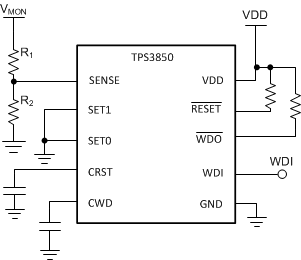ZHCSFP2B October 2016 – September 2021 TPS3850
PRODUCTION DATA
- 1 特性
- 2 应用
- 3 说明
- 4 Revision History
- 5 Pin Configuration and Functions
- 6 Specifications
- 7 Detailed Description
- 8 Application and Implementation
- 9 Power Supply Recommendations
- 10Layout
- 11Device and Documentation Support
- 12Mechanical, Packaging, and Orderable Information
7.3.4 Adjustable Operation Using the TPS3850H01
The adjustable version (TPS3850H01) can be used to monitor any voltage rail down to 0.4 V using the circuit illustrated in Figure 7-4. When using the TPS3850H01, the device does not function as a window comparator; instead, the device only monitors the undervoltage threshold. To monitor a user-defined voltage, the target threshold voltage for the monitored supply (VMON) and the resistor divider values can be calculated by using Equation 1 and Equation 2, respectively:

Equation 1 can be used to calculate either the negative threshold or the positive threshold by replacing VITx with either VITN or VITN + VHYST, respectively.
Large resistor values minimize current consumption; however, the input bias current of the device degrades accuracy if the current through the resistors is too low. Therefore, choosing an RTOTAL value so that the current through the resistor divider is at least 100 times larger than the maximum SENSE pin current (ISENSE) ensures a good degree of accuracy; see the IQ vs Accuracy Tradeoff In Designing Resistor Divider Input To A Voltage Supervisor (SLVA450) application report for more details on sizing input resistors.
 Figure 7-4 Adjustable Voltage Monitor
Figure 7-4 Adjustable Voltage Monitor